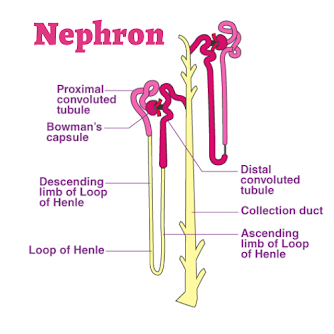Structure of Kidney
Colour of kidney:
Kidney are dark red bean shaped organ.
Size of kidney:
Each kidney is 10cm long, 5cm width thick and weights about 120 grams.
Location:
They are placed against the back wall of abdominal cavity just below diaphragm , one on either side of the vertebral column. They are protected by the last 2 ribs. The left kidney is little higher than the right.
Hilus:
The concave side of the kidney faces the vertebral column. There is a depression called Hilus, near the Centre of the concave area of kidney.
Kidney shows two regions
Renal cortex:
is the outer part of the kidney and it is dark red in colour.
Renal medulla:
is the inner part of the kidney and is pale red in colour. Renal medulla consists of several cone shaped areas called renal Pyramids. Renal pyramids projects into a funnel-shaped cavity called renal Pelvis which is the base of ureter.
 |
| Structure of kidney |



.png)
No comments:
Post a Comment